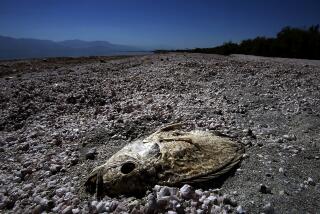Oil Spill Off Alaska Continues to Disrupt Salmon Fishing
ANCHORAGE â Drew Sparlin has been spending his days in a 40-foot boat on the choppy waters of Cook Inlet, doing something hundreds of other commercial fishermen in this part of Alaska can only think about this year.
Heâs been fishing.
Sparlinâs boat, the Lady Lee, is one of a half-dozen vessels leaving the fishing port of Kenai every day in search of migrating salmon--and globs of floating oil--as part of a test to see how much oil is in the fishing grounds of Central Cook Inlet.
Until this week, Sparlin had found only fish. But that changed Wednesday afternoon, when he discovered a series of foamy, rust-brown streaks of floating oil in an area scheduled to be opened for fishing later in the week. As a result, another salmon opening was canceled.
Spill Causes Havoc
More than three months after the Exxon Valdez ran aground in Prince William Sound, causing the biggest oil spill in the nationâs history, oil in Alaska waters continues to cause havoc in the stateâs billion-dollar salmon fishery.
The first two weeks in July would normally be the peak period for commercial fishing in dozens of areas along the south central Alaska coastline. Five different species of salmon migrate by the millions from the Pacific Ocean to the freshwater streams of their birth, and the bays and passages of Prince William Sound, Kodiak Island, Cook Inlet and the Alaska Peninsula are normally filled with fishing vessels and floating processing ships.
But because of lingering oil, only a few of the fishing grounds in this part of Alaska have been opened this summer by state fishing authorities. Others have either been closed for the season or indefinitely delayed. The places range from bays in Prince William Sound where oil still coats the beaches to remote regions as far as 500 miles away where wisps of oily sheen have been seen.
There have been no reports of oil contaminated fish. Oil floats and fish swim beneath the surface of the water, avoiding it. Yet state officials and the fishing industry, fearing that even the hint of oiled salmon will taint Alaskaâs reputation for pristine-quality seafood, have instituted a so-called âzero-toleranceâ policy, banning all fishing in places where even small amounts of oil are detected.
Find Streaks, Tar Balls
What he and others have found, more than 200 miles from where the tanker grounded, has not been huge amounts of pollution. Instead, they have found occasional foamy streaks of emulsified oil known as mousse, and hard, black tar balls that have evolved from the crude oil that spilled March 24.
âItâs all so scattered you canât go out and pick it up or skim it up,â said Sparlin, who has fished for salmon and herring for 24 years. âPeople donât know what to do. In this district alone thereâs 600 boats. Youâve got a couple thousand people, just right here, sitting and doing nothing. No one knows what to expect . . . everybodyâs disgusted.â
The Exxon spill came at a time when record salmon catches were expected in many places. In areas beyond the oilâs reach, such as Bristol Bay or in southeast Alaska, fishing has been stronger than ever this year, and fish from those areas are being airlifted by the ton to canneries in this region. No one is sure how much of the season can be salvaged in the areas affected by oil, but hopes are growing dimmer as the days pass and new seasons are delayed.
In Kodiak, 250 miles south of Prince William Sound, hundreds of boats are docked in the harbor, their crews awaiting the latest word on which areas will be opened. Earlier this week, only three of 52 fishing districts were open there. Fishermen are afraid to leave town because of the possibility of a sudden opening, but there has been little fishing since the first closure a month ago.
âYou see people walking around kind of going crazyâ said Rhonda Ellingson, whose husband, Rick, began netting salmon off southern Kodiak Island last week after a three-week delay. âThereâs nothing to do. Youâre supposed to be out fishing making money, and instead theyâre living on a tied-up seine boat with five other guys and not knowing when theyâre going out.â
Exxon has agreed to pay fishermen for any documented losses. And some of them have gone on the Exxon payroll, renting out their boats for shore clean-up jobs, or like Sparlin, participating in test fisheries with state biologists and Exxon claims adjusters on board. But many fishermen are skeptical that Exxon will pay the full amount of their losses. In Cook Inlet, fishermen grumble that they are still awaiting settlements from a smaller tanker spill two summers ago.
David Hulen, a staff writer for the Anchorage Daily News, filed this story for The Times.
More to Read
Sign up for Essential California
The most important California stories and recommendations in your inbox every morning.
You may occasionally receive promotional content from the Los Angeles Times.










